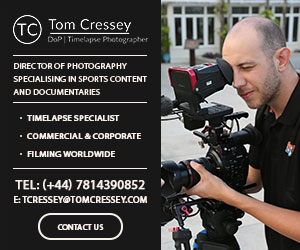Broadcast News
16/02/2015
Journey To The New World – Part 2

In the second of two articles, Tom Swan, Sales and Marketing Director at leading systems integrator dB Broadcast, considers the challenges of the transition to a digital, data-driven world and reflects on how ready the industry is to embrace it.
Vision Systems
The broadcast industry is in a transition period of emerging video standards which are being rolled out by many of the established technology vendors. We are seeing a proliferation of formats at a rate of change not seen before. This generates many initial conceptual product ideas, ultimately coming through as deliverable product developments in new technology areas, and therefore many potential benefits for broadcasters. However, broadcasters have invested heavily in current technology and in tried and tested infrastructure. New video production technology has the potential to create more cost efficient, faster and simpler workflows, but there is a significant concern around reliability and the capital investment in adapting core infrastructure to allow this technology to be utilised properly.
New production techniques are being explored at a greater rate than ever before by end users, while vendors are pushing the boundaries of viable technology for production use. IP production has become a real talking point in the past couple of years, heightened by trade events/exhibitions such as IBC, BVE and IP Connect. There are arguments for a full IP studio production or a hybrid mix of SDI and IP, both of which provoke much debate and deliberation.
Stagebox (originally developed by BBC R&D, licensed by L2tek), allows a fully IP workflow from the point of acquisition. This would enable the use of low cost commodity switches instead of high cost SDI routers; Stagebox can achieve full studio grade camera connectivity down a single Cat6 cable. This means that outside broadcast production transmission can be sent down secure IP links such as MPLS networks to the fixed studio, and integrated within the studio IP production seamlessly.
The IT industry has been ahead of the broadcast industry for the past decade. While SMPTE 424M-2006 (3Gb/s over a single SDI link) was ratified for broadcast, 10Gb/s Ethernet capable infrastructure in the IT domain was becoming common. We can apply this technology maturity shift to the present day. The broadcast industry is pushing for 6Gb/s & 12Gb/s SDI while the IT industry is deploying networks with bandwidths in excess of 40Gb/s.
Technology standards such as AVB (IEEE 802.1BA) may help the broadcast industry merge technologies with the IT industry and keep up with bandwidth demands. Current IP over Ethernet connection is based on 'best effort delivery' and is non-deterministic. For broadcasters, sending their media and assets using a non-synchronous 'fire and forget' strategy is very risky. AVB allows constant bandwidth allocation for single or multiple streams over time. This allows for consistent, anticipated file delivery via a low latency medium. Ethernet does not have its own timing and sync mechanism; in AVB signals are time stamped on dispatch to ensure the signal is synchronous on entering the broadcast system.
AVB compliant systems are supported by the AVnu Alliance (Axon, Cisco, Intel and Shure to name a few).
Signal routing is being pushed in various directions by the major vendors, while collaborations between broadcast and IT manufacturers are becoming more common during this emerging standards transition period. Snell and Cisco have partnered to deliver the next generation of IP based routing and infrastructure. This partnership is highly valuable to the broadcast industry as Snell understand the issues broadcasters face today and Cisco are an industry leader in IT product development. Through a migration path of a hybrid IP/SDI system, both companies can collaborate in building understanding of the broadcast market needs to provide IP based routing and infrastructure based on existing network topology and standards.
The ever increasing demand for higher resolutions at faster frame rates really pushes the infrastructure the industry has become accustomed to. As a leading SI, dB has found within the video production side that in the past few years HD-SDI (with a 3G capability) has been the norm, and only recently are we seeing a fibre infrastructure becoming more common. As video production becomes more demanding on the existing infrastructure, we will start to reach the limits of what we currently have.
Audio Systems
Audio system manufacturers are actively pursuing a number of open standards such as AVB and Ravenna. Whilst there are clear and obvious benefits to an open, interoperable networking standard, there is still work to be done to provide truly interoperable control interfaces, allowing simple set-up and configuration. Calrec point to the impressive performance of their proprietary audio networking platform. Hydra2 has negligible latency, very high bandwidth, solid redundancy etc., and offers features including integrated control, sophisticated protection and sharing and error detection and warning. They see this as the core backbone for routing of audio in and out of DSP processors and around a facility for a number of years to come.
Calrec offer a range of interfaces to bridge the Hydra2 platform with popular standards such as Dante, Ravenna & AVB, it will provide users with a powerful, flexible and scalable solution, leveraging the power of Hydra2 and existing infrastructure, whilst opening up the benefits of interoperable networking, and easing the transition whilst newer standards mature.
An open standard allowing for the interconnection of separate Hydra2 networks and standalone IO units via IP over WAN, as though they are all on the same local network, would be extremely advantageous when considering centralising the audio processing element of a regional operation.
dB Broadcast strongly believes that to be a successful SI in the broadcast industry it is essential to understand the operational and commercial needs of clients, and that can only be achieved through partnerships and working closely with broadcasters and equipment manufacturers.
The article is also available to read in BFV online.
(IT/JP)
Vision Systems
The broadcast industry is in a transition period of emerging video standards which are being rolled out by many of the established technology vendors. We are seeing a proliferation of formats at a rate of change not seen before. This generates many initial conceptual product ideas, ultimately coming through as deliverable product developments in new technology areas, and therefore many potential benefits for broadcasters. However, broadcasters have invested heavily in current technology and in tried and tested infrastructure. New video production technology has the potential to create more cost efficient, faster and simpler workflows, but there is a significant concern around reliability and the capital investment in adapting core infrastructure to allow this technology to be utilised properly.
New production techniques are being explored at a greater rate than ever before by end users, while vendors are pushing the boundaries of viable technology for production use. IP production has become a real talking point in the past couple of years, heightened by trade events/exhibitions such as IBC, BVE and IP Connect. There are arguments for a full IP studio production or a hybrid mix of SDI and IP, both of which provoke much debate and deliberation.
Stagebox (originally developed by BBC R&D, licensed by L2tek), allows a fully IP workflow from the point of acquisition. This would enable the use of low cost commodity switches instead of high cost SDI routers; Stagebox can achieve full studio grade camera connectivity down a single Cat6 cable. This means that outside broadcast production transmission can be sent down secure IP links such as MPLS networks to the fixed studio, and integrated within the studio IP production seamlessly.
The IT industry has been ahead of the broadcast industry for the past decade. While SMPTE 424M-2006 (3Gb/s over a single SDI link) was ratified for broadcast, 10Gb/s Ethernet capable infrastructure in the IT domain was becoming common. We can apply this technology maturity shift to the present day. The broadcast industry is pushing for 6Gb/s & 12Gb/s SDI while the IT industry is deploying networks with bandwidths in excess of 40Gb/s.
Technology standards such as AVB (IEEE 802.1BA) may help the broadcast industry merge technologies with the IT industry and keep up with bandwidth demands. Current IP over Ethernet connection is based on 'best effort delivery' and is non-deterministic. For broadcasters, sending their media and assets using a non-synchronous 'fire and forget' strategy is very risky. AVB allows constant bandwidth allocation for single or multiple streams over time. This allows for consistent, anticipated file delivery via a low latency medium. Ethernet does not have its own timing and sync mechanism; in AVB signals are time stamped on dispatch to ensure the signal is synchronous on entering the broadcast system.
AVB compliant systems are supported by the AVnu Alliance (Axon, Cisco, Intel and Shure to name a few).
Signal routing is being pushed in various directions by the major vendors, while collaborations between broadcast and IT manufacturers are becoming more common during this emerging standards transition period. Snell and Cisco have partnered to deliver the next generation of IP based routing and infrastructure. This partnership is highly valuable to the broadcast industry as Snell understand the issues broadcasters face today and Cisco are an industry leader in IT product development. Through a migration path of a hybrid IP/SDI system, both companies can collaborate in building understanding of the broadcast market needs to provide IP based routing and infrastructure based on existing network topology and standards.
The ever increasing demand for higher resolutions at faster frame rates really pushes the infrastructure the industry has become accustomed to. As a leading SI, dB has found within the video production side that in the past few years HD-SDI (with a 3G capability) has been the norm, and only recently are we seeing a fibre infrastructure becoming more common. As video production becomes more demanding on the existing infrastructure, we will start to reach the limits of what we currently have.
Audio Systems
Audio system manufacturers are actively pursuing a number of open standards such as AVB and Ravenna. Whilst there are clear and obvious benefits to an open, interoperable networking standard, there is still work to be done to provide truly interoperable control interfaces, allowing simple set-up and configuration. Calrec point to the impressive performance of their proprietary audio networking platform. Hydra2 has negligible latency, very high bandwidth, solid redundancy etc., and offers features including integrated control, sophisticated protection and sharing and error detection and warning. They see this as the core backbone for routing of audio in and out of DSP processors and around a facility for a number of years to come.
Calrec offer a range of interfaces to bridge the Hydra2 platform with popular standards such as Dante, Ravenna & AVB, it will provide users with a powerful, flexible and scalable solution, leveraging the power of Hydra2 and existing infrastructure, whilst opening up the benefits of interoperable networking, and easing the transition whilst newer standards mature.
An open standard allowing for the interconnection of separate Hydra2 networks and standalone IO units via IP over WAN, as though they are all on the same local network, would be extremely advantageous when considering centralising the audio processing element of a regional operation.
dB Broadcast strongly believes that to be a successful SI in the broadcast industry it is essential to understand the operational and commercial needs of clients, and that can only be achieved through partnerships and working closely with broadcasters and equipment manufacturers.
The article is also available to read in BFV online.
(IT/JP)
Top Related Stories
Click here for the latest broadcast news stories.
31/01/2008
Gee Broadcast Serves Up Video Over IP & Lip Sync Analysis At Broadcast LIVE & VideoForum
On show this year at Broadcast LIVE & VideoForum are the Geevs MR family of flexible Servers for Post Production, Production and Transmission working
Gee Broadcast Serves Up Video Over IP & Lip Sync Analysis At Broadcast LIVE & VideoForum
On show this year at Broadcast LIVE & VideoForum are the Geevs MR family of flexible Servers for Post Production, Production and Transmission working
22/10/2018
Production News : London Mayor And Film Industry Leaders Tackle Diversity In The Film Industry
The Mayor of London, Sadiq Khan, and major film industry leaders have teamed up to tackle the lack of diversity in the film industry. Sony Pictures, H
Production News : London Mayor And Film Industry Leaders Tackle Diversity In The Film Industry
The Mayor of London, Sadiq Khan, and major film industry leaders have teamed up to tackle the lack of diversity in the film industry. Sony Pictures, H
27/02/2006
Industry confidence high, reports IABM Industry Trends Survey
Respondents to the IABM Industry Trends Survey have revealed that their confidence is high with just over half stating increased confidence in the nex
Industry confidence high, reports IABM Industry Trends Survey
Respondents to the IABM Industry Trends Survey have revealed that their confidence is high with just over half stating increased confidence in the nex
03/03/2025
Broadcast Solutions Invites The Media Industry To See The Latest In Technology
Continuing a long tradition, Broadcast Solutions is once again inviting all those involved in media technology implementations to its biannual Broadca
Broadcast Solutions Invites The Media Industry To See The Latest In Technology
Continuing a long tradition, Broadcast Solutions is once again inviting all those involved in media technology implementations to its biannual Broadca
14/02/2020
Considerations When Deploying Cloud Technology In The Broadcast Industry
Central to modern cloud strategy is the ability to integrate best-of-breed tools into a system that best fits the individual needs of a specific enter
Considerations When Deploying Cloud Technology In The Broadcast Industry
Central to modern cloud strategy is the ability to integrate best-of-breed tools into a system that best fits the individual needs of a specific enter
25/06/2012
'Broadcast And Media Technology — Understanding Your Industry' Launches In Germany
The IABM (International Association of Broadcasting Manufacturers) Training Academy today announced that it will offer its "Broadcast and Media Techno
'Broadcast And Media Technology — Understanding Your Industry' Launches In Germany
The IABM (International Association of Broadcasting Manufacturers) Training Academy today announced that it will offer its "Broadcast and Media Techno
04/06/2009
Tough Trading Remains The Theme For Broadcast And Media Technology Industry
With two excellent years in 2007 and 2008, the broadcast and media technology industry is enduring a difficult year in 2009 with limited confidence fo
Tough Trading Remains The Theme For Broadcast And Media Technology Industry
With two excellent years in 2007 and 2008, the broadcast and media technology industry is enduring a difficult year in 2009 with limited confidence fo
09/07/2018
IP Showcase Returns To IBC
Major technical and standards organizations within the broadcast industry — Audio Engineering Society (AES), Alliance for IP Media Solutions (AIMS), A
IP Showcase Returns To IBC
Major technical and standards organizations within the broadcast industry — Audio Engineering Society (AES), Alliance for IP Media Solutions (AIMS), A
24/11/2017
Adder Technology Joins Industry Shift To Open Standards With AIMS
Adder Technology has announced that it has become an associate member of the not-for-profit trade alliance, the Alliance for IP Media Solutions (AIMS)
Adder Technology Joins Industry Shift To Open Standards With AIMS
Adder Technology has announced that it has become an associate member of the not-for-profit trade alliance, the Alliance for IP Media Solutions (AIMS)
06/07/2011
Panasonic Announce Broadcast & Production Ltd as Authorised Panasonic Broadcast Dealer
Established in 2003, Broadcast & Production Services (BPS) is one of the UK's leading suppliers of broadcast video and audio equipment and effective f
Panasonic Announce Broadcast & Production Ltd as Authorised Panasonic Broadcast Dealer
Established in 2003, Broadcast & Production Services (BPS) is one of the UK's leading suppliers of broadcast video and audio equipment and effective f
31/05/2005
Gee Broadcast and Lightworks to collaborate at the Broadcast Production Show
Gee Broadcast Systems Ltd and Lightworks UK Ltd will exhibit together at the Broadcast Production Show at Earls Court in London from June 1-3 2005. Fe
Gee Broadcast and Lightworks to collaborate at the Broadcast Production Show
Gee Broadcast Systems Ltd and Lightworks UK Ltd will exhibit together at the Broadcast Production Show at Earls Court in London from June 1-3 2005. Fe
09/10/2003
ATG Broadcast to create production village for BBC Broadcast
One of Europe's leading systems integrators, ATG Broadcast, has been selected to design and build a fully digital production village within BBC Broadc
ATG Broadcast to create production village for BBC Broadcast
One of Europe's leading systems integrators, ATG Broadcast, has been selected to design and build a fully digital production village within BBC Broadc
26/11/2024
Ikegami Sees Accelerating Adoption of IP and Mixed-Format Broadcast Production
Ikegami has reported an accelerating migration to high-efficiency IP and mixed-format UHD/HD content creation throughout 2024. Product developments an
Ikegami Sees Accelerating Adoption of IP and Mixed-Format Broadcast Production
Ikegami has reported an accelerating migration to high-efficiency IP and mixed-format UHD/HD content creation throughout 2024. Product developments an
28/01/2016
Trilogy Supports All-IP Live Broadcast Production
Trilogy, a supplier of intercom solutions and master reference generators for the broadcast industry, was one of a group of industry partners who supp
Trilogy Supports All-IP Live Broadcast Production
Trilogy, a supplier of intercom solutions and master reference generators for the broadcast industry, was one of a group of industry partners who supp
27/01/2016
VRT LiveIP Performs World's First Full IP Remote Broadcast Production
Nevion, a leader in transporting media from the camera to the home, has assisted the LiveIP Project in broadcasting the first remote production of a l
VRT LiveIP Performs World's First Full IP Remote Broadcast Production
Nevion, a leader in transporting media from the camera to the home, has assisted the LiveIP Project in broadcasting the first remote production of a l















